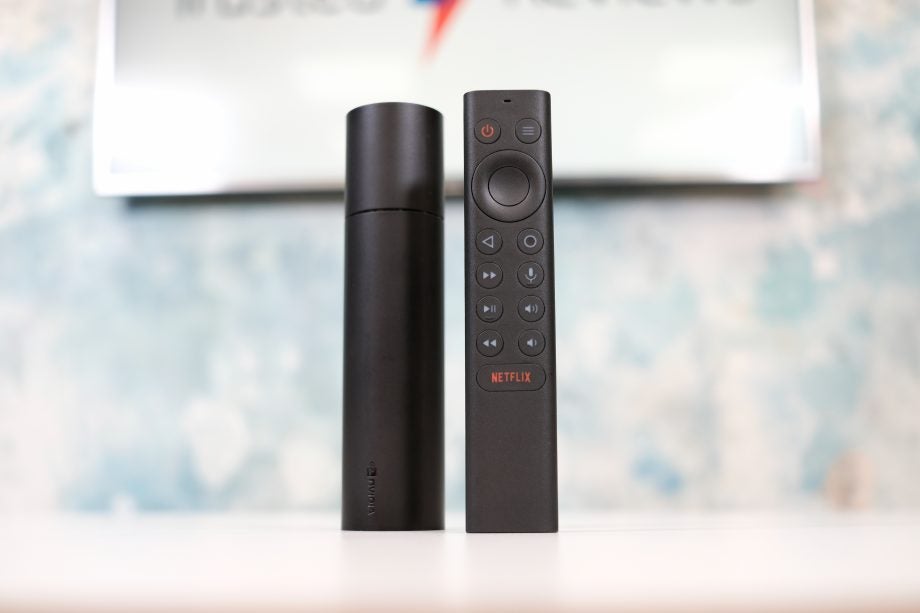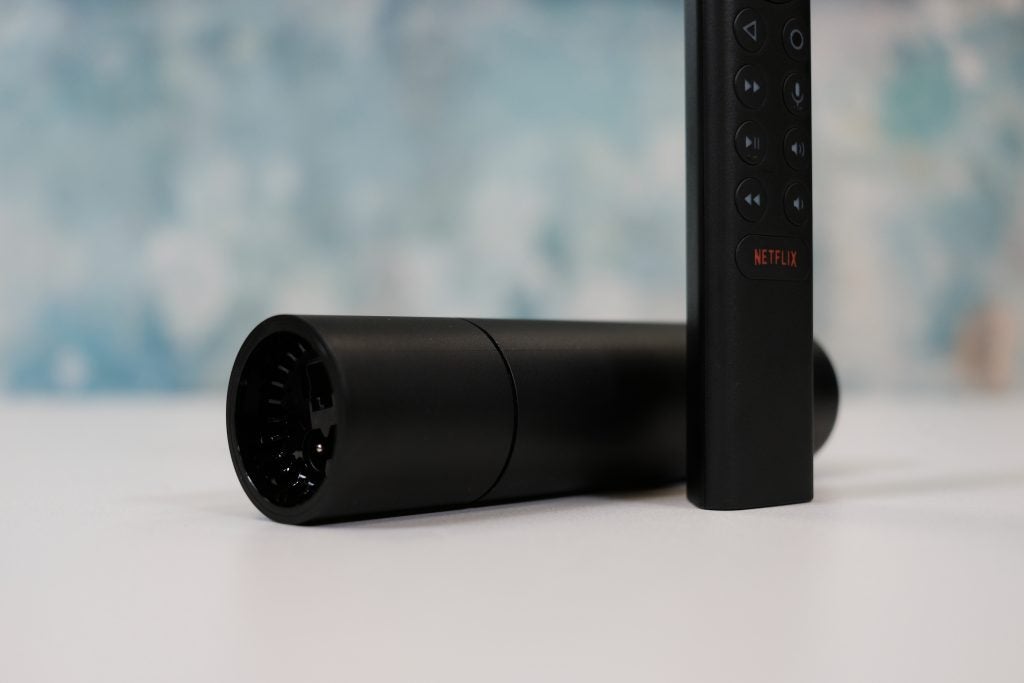Nvidia Shield TV (2019) Review
A no-brainer box for gamers


Verdict
The Nvidia Shield TV is among the very best premium Android streaming boxes thanks to support for Dolby Vision and Dolby Atmos, while still offering users the capability to stream 4K content from popular streaming services. Add in its incredible Stadia-rivalling cloud-streaming gaming potential, and this becomes a no-brainer box for gamers.
Pros
- 4K and HDR visuals looks incredible
- Cinema-quality audio
- Redesigned remote
- GeForce Now cloud streaming is a game changer
Cons
- No app for Now TV
- Requires strong internet connection for cloud gaming
Key Specifications
- Review Price: £149
- 4K, HDR playback
- Dolby Vision + Dolby Atmos
- Tegra X1+ processor
- 2GB RAM
- 8GB storage
- GeForce Now
- Google Assistant and Alexa
What is the Nvidia Shield TV?
The Nvidia Shield TV is an Android streaming box, allowing easy access to a huge library of TV apps such as Netflix, Amazon’s Prime Video and more. Since this device is from graphics card manufacturer Nvidia, it shouldn’t come as a shock that it offers a gaming-focused spin on the likes of the Amazon Fire TV and Apple TV ranges.
With GeForce Now – Nvidia’s answer to Google Stadia – available on the Shield TV, you’ll be able to stream games you own on Steam, Origin or uPlay via the cloud. This means the Shield TV’s hardware has no limits on performance, with the speed and reliability of your internet connection the only obstacle to play the latest and greatest video games at max graphics settings.
The 2019 edition of the Shield TV further improves experiences for both gaming and TV, with a Tegra X1+ processor speeding up the performance, Dolby Vision HDR and AI upscaling boosting the picture quality and Dolby Atmos support levelling up your audio to such an extent your local multiplex will turn green with envy.
Nvidia also made sure to remove the perception the Shield TV is exclusively for gamers by ditching the mini console design (at least for the entry-level model) and redesigning the remote so it no longer looks out of place in the living room. Best of all, the Shield TV is launching at its cheapest price, an affordable £149.99. But is that enough for to be champion of the TV streaming boxes?
Related: Best Streaming Sites
Design and controller
- Radical makeovers
Previous editions of the Shield TV looked like a miniature Xbox. While I’m sure plenty of gamers appreciated this, it also likely turned off many who thought the overbearing design would look jarring in the living. The new entry-level Nvidia Shield TV box is rocking a far more low-profile design – in fact, it’s so low profile you could mistake it for a power brick.
The Nvidia Shield TV is a small, slender black cylinder. It doesn’t look like much, but it’s designed to disappear out of sight behind the television instead of being proudly displayed. While I really love this subtle design approach, it does come with drawbacks, as there’s limited room for ports. There’s only wired connections for power, Ethernet HDMI and storage expansion via MicroSD card.
Don’t worry gamers, the new Pro model of the Shield TV still retains the overt gaming style and USB 3.0 ports for hooking up your gaming keyboard and mouse if those are both crucial features for you – although you’ll have to offer up an extra £50 for the privilege.
The Nvidia Shield TV remote has also seen a massive design overhaul, now looking far more approachable and accessible to non-gamers. Playback control buttons have been added, making it easier to pause, fast forward or alter the volume, while a dedicated Netflix button ensures accessing the world’s most popular streaming service is an absolute doddle. The microphone button remains here too, so you can bring up Google Assistant to take you to your favourite TV show without faffing with menus.

Google Assistant is reasonably accurate, but its functionality is limited with Shield TV. It can easily whip up any film or TV show from Netflix and the Google Play Store at command for example, but it faltered when opening The Apprentice on BBC iPlayer. Google Assistant also refused to acknowledge the existence of GeForce Now, so I had to open up all my games manually – first-world problems ey? The Shield TV also supports Alexa now too, so you still boss the system around if you’re loyal to Amazon’s assistant.
Nvidia has introduced additional nifty extra features to the remote too, including a motion-activated backlight, IR control for your TV and video/equipment and a lost-remote locator. These may sound insignificant on paper, but every one of these features helps to eradicate all the faff and stress when settling down to watch TV.
The remote also uses 2x AAA batteries (provided in the box) which apparently last six months of use before requiring replacements. This is a welcome change from using disc, batteries which were an absolute pain to replace, so kudos to Nvidia for listening to customer feedback.
Overall, I’m a big fan of the remote. The toblerone shape and miniature size ensure its comfortable to hold, while Bluetooth connectivity means you don’t have to accurately point at the device for your commands to be registered. In terms of upgrades from the previous generation Shield TV, the controller redesign is certainly among the best.
The Shield gamepad no longer comes bundled with the Shield TV. Instead, Nvidia has allowed you to hook up your own Bluetooth controllers, which includes pads from both the PS4 and Xbox One, or even your old Shield controller. Pairing them is a very simple – following some quick fiddling in the settings, and you’re good to go. I’m a big fan of Nvidia letting users pick their own pad of choice, while not forcing their own in a bundle helps to keep the cost down.
Related: Best TVs 2019
Dolby Vision, Dolby Atmos and AI Upscaling
The Nvidia Shield TV is a premium streaming TV box, allowing you to watch content in 4K via the likes of Netflix, Prime Video and even the upcoming Disney Plus. The new iteration goes several steps further, also enabling support for Dolby Vision and Dolby Atmos.
Dolby Vision is a high dynamic range (HDR) video format, which helps to increase the range of colours displayed on screen while also boosting the brightness, resulting in a drastically improved picture. The only issue here is Dolby Vision content is limited, with only select modern films (Avengers Infinity War and Solo: A Star Wars Story etc) and Netflix originals (Stranger Things, Altered Carbon and more) supporting the technology.

Provided by Nvidia
Dolby Atmos, meanwhile, is a surround-sound technology which proves to be a big step up from what you get with 5.1 and 7.1 surround sound. The major improvement here is that sound occupies a more vertical space, as its blasted from the ceiling and floor and gives the illusion that a whirring helicopter or roaring dinosaur is directly above you. Again, Dolby Atmos support isn’t plentiful, with a very limited Netflix Originals library – restricted to the likes of The Haunting of Hill House, nature documentary Our Planet and Breaking Bad movie El Camino – taking advantage of it. Dolby Atmos really does offer a cinema-esque experience to the living room though, providing a level of immersion I didn’t think possible in the living room.
Another limitation for Dolby Vision and Dolby Atmos is the hardware required. You’ll need a Dolby Atmos-compatible TV and Dolby Atmos certified sound system for the technology to work, and neither of them come cheap. For the record, I used the Samsung HW-Q90R, and it sounded incredible, but that costs a whopping £1499. Both technologies are of course very welcome additions, but unless you have the required hardware, it’s probably not worth upgrading to the new Shield TV.
There is another exciting feature with the new Shield TV which doesn’t require such an extravagant setup: AI upscaling. This technology allows you to convert 720p and 1080p content to 4K, making images look sharper and more detailed. While upscaling is nothing new, Nvidia claims the computing power of the Tegra Z1+ chip allows for a more enhanced upscaling process. The final picture won’t look quite as good as native 4K content, but it still often results in a remarkably improved picture.

Provided by Nvidia
Nvidia demonstrated the power of AI upscaling with an episode of Game of Thrones. Since only season one currently supports 4K, it was a marvel to see the larger pixel count finally give Westeros the extra shine it truly merits. With AI enhanced, the medieval clothing suddenly looked more textured, while background scenery looked noticeably less blurry.
After taking the Shield TV home, I soon realised AI Upscaling can be hit and miss. It actually made Lord of the Rings look worse, with the artificial intelligence making the film look more grainy. Nvidia acknowledge the upscaling technology won’t make every film look better, and so does allow you to turn the feature off with a single press of a button.
I found animated films to be one of the biggest benefactors of AI upscaling, with the likes of Shrek and Coco looking significantly sharper. With most content though, I really had to squint to see the difference. AI Upscaling, then, is certainly a good addition for the Nvidia Shield TV, although I’m unconvinced it provides enough of a difference to merit an upgrade from an older Shield device.
Elsewhere, the Shield TV retains the same high quality of its predecessors. There’s a massive library of TV apps here, including the classics such as Netflix, Prime Video, YouTube and BBC iPlayer, while also boasting more obscure cult favourite options such as Crunchyroll, Rakuten Viki and Ted Talks. With even Disney Plus confirmed, its future proofed for entrainment too. The only significant omission I could find was Now TV, but I did have the option to cast the Now TV mobile app to the Shield TV, so it’s not a massive issue.
There are also many non-TV streaming services available through the Google Play Store, such as Spotify, Twitch and Plex. Even NordVPN is here, which I imagine will you let you access the US Netflix from British soil, although the VPN’s recent hacking scandal does make that option less attractive.
The interface remains the same as previously too. I think it’s fine, with the Android software organising your streaming services and games into separate rows. It’s all customisable too, so you can pin your most used apps to the top for easy access. Navigating Google Play for new apps can be a pain though, especially since it prompts you to use voice commands for search which isn’t always reliable. Nvidia assured me it will continue to regularly update the Shield TV though, so don’t rule out an improved interface further down the line.
Related: Apple TV 4K review
Gaming
- GeForce Now and GameStream
The Shield TV is a fantastic device for streaming films and TV, but there’s no doubt its greatest ace card is its gaming credentials. You’ve the option to play Android games locally, stream games from your own PC or use cloud streaming via GeForce Now. Not one of these features are new or exclusive for the 2019 edition of the Shield TV, but there’s no doubt Nvidia has made huge strides in the gaming department since the previous Shield TV device first launched.
Nvidia’s GeForce Now allows you to play AAA video games without the need for high-end hardware. This means you’ll be able to play GPU-demanding games on the low-powered Shield TV, putting your PlayStation and Xbox to shame. This cloud-streaming service is very similar to what Google Stadia offers, but instead of being forced to buy games directly from Nvidia, you can instead port titles over from over online game stores such as Stream, EA Origin and Uplay.
With a purchase of a Shield TV, you also get access to 42 games via GeForce Now for free. Most of these titles are admittedly pretty old, but there are still some fantastic picks including Batman: Arkham City, BioShock Remastered and Borderlands.
I installed Hitman 2 from my Steam library to test out GeForce now, and was shocked to see how smooth the performance was – I didn’t notice any performance lag or frame rate drop once. Of course, your internet connection is detrimental for the performance of GeForce Now, but my 35mbps broadband coped just fine.
There are teething problems with the service though. For example, despite prompting me to use a gamepad to play Fortnite, I couldn’t log into the game without a keyboard. Since the entry-level Shield TV doesn’t have USB ports, it’s impossible to play the battle-royale shooter without using a Bluetooth keyboard, which is very odd.

It’s also worth noting that while GeForce Now is currently free, this could change once the public beta ends and the service officially launches. I suspect Nvidia will offer a free subscription tier like Google Stadia though, limiting the performance to Full HD at 60fps, but it’s impossible to know for sure. If Nvidia gets it right, GeForce Now really does have the potential to blow Google Stadia out of the water and make the Shield TV a viable alternative to the PS5 and Xbox 2.
The Shield TV also allows you to directly stream titles from your own gaming PC. This makes it possible to play games on the Shield TV which are stored on your gaming PC, which comes in handy if you want to swap from your monitor to your living room’s ultra-wide television. You’ll need to have an Nvidia GeForce graphics card and a reliable internet connection for this to work though.
Just in case you don’t have good internet, the Shield TV also allows you to buy and play Android games locally too. These are made up mostly of indie and mobile titles, but there are a couple of gems here such as Super Meat Boy, Star Wars: KOTOR and a number of old Final Fantasy entries.
The Shield TV Pro edition has access to an even larger library of Android games such as Half-Life 2, Portal 2, Resident Evil 5, Tomb Raider and more. This is thanks to the system’s greater 3GB RAM, but with GeForce Now already offering access to these titles on the standard Shield TV (provided you’re subscribed to the service) I personally think you’re better off saving the £50, unless you really want to use a wired keyboard and mouse with Shield.
Related: Nvidia GeForce Now
Should I buy the Nvidia Shield TV?
The new Nvidia Shield TV has a number of improvements over the previous generation model, with Dolby Vision and Dolby Atmos support being the most prevalent. However, unless you have the high-end hardware to enable such technology, I really don’t think there’s enough here to justify an upgrade from an old Shield TV device.
If you’re new to Shield though, it’s another matter entirely. With 4K HDR streaming capabilities, an abundance of apps and a more affordable £149 price, the Shield TV has a great shouting of being the very best Android TV box on its streaming skills alone.
If you’re a gamer who would take advantage of the GeForce Now cloud-streaming service though, the Shield TV becomes a no brainer. Being able to play all my Steam, Uplay and Origin video games with no need for a high-end hardware is mind boggling, and I’m still struggling to fathom how smooth the performance is. With GeForce Now still in beta, there are still a lot of questions hanging over the service, including subscription costs and game support.
If Nvidia gets it right with GeForce Now though, then the Shield TV will not only be the best of the best for TV streaming, but could well usurp Google Stadia as the go-to cloud-streaming console king too.
Verdict
The Nvidia Shield TV is among the very best premium Android streaming boxes thanks to support for Dolby Vision and Dolby Atmos, while still offering users the capability to stream 4K content from popular streaming services. Add in its incredible Stadia-rivalling cloud-streaming gaming potential, and this becomes a no-brainer box for gamers.


